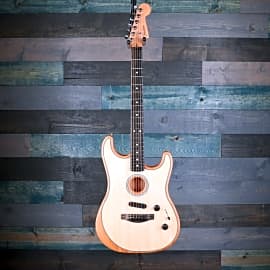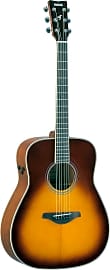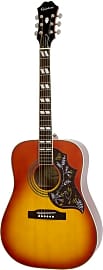The 10 Best Acoustic Electric Guitars

This wiki has been updated 31 times since it was first published in October of 2017. Musicians looking for a versatile instrument they can use to practice quietly at home as easily as they can to jam out for hordes of adoring fans would do well to consider one of the acoustic electric guitars on our list. Each comes equipped with a pickup that's capable of amplifying your sound without the use of an external microphone, allowing you to roam the stage as you see fit. When users buy our independently chosen editorial choices, we may earn commissions to help fund the Wiki.
Editor's Notes
December 17, 2020:
Players who are interested in top-of-the-line models should first look into the Martin SC-13E and Fender Acoustasonic. These recent releases are made from high-quality components and boast previously unseen body designs and features. The Yamaha Transacoustic is similarly cutting edge given its built-in effects, however it provides an alternative for those who cannot afford the aforementioned models. If you find such luxuries uninteresting and simply want a straightforward instrument that works, you may be better off with selections like the PRS SE P20E, Epiphone AJ-210CE, Yamaha FS 820, or even the Vangoa 3/4 Guitar if you're just starting out.
February 27, 2019:
The Fender T-Bucket got an upgrade from the company that includes a wildly interesting and naturally occurring pattern in the maple, and it moved up compared to its old spot on the list for purely aesthetic reasons. The Ovation, on the other hand, took a bit of a nose dive, as the tone proved to be rather thin when put to the task. Elsewhere, models by Epiphone made gains, but the Martin DRS1 still reigns supreme.
Amplifying Your Acoustic Guitar With Ease
That's because the specific tone and timbre of an acoustic guitar is far more sensitive to the amplification process than that of an electric guitar.
Guitarists like to play loud. This is particularly true among guitarists who rock out with electric guitars, but acoustic players have just as much of a desire — and sometimes more of a need — for high-quality amplification as their electric brethren. That's because the specific tone and timbre of an acoustic guitar is far more sensitive to the amplification process than that of an electric guitar.
Both acoustic and electric guitars derive their personalities from a combination of variables, but when an electric guitar’s pickups receive their information from the strings, it is purely the translation of magnetic energy into an audio signal. And since electric guitars aren't intended to be played unplugged, this sound is the unadulterated identity of a given electric. With an acoustic guitar, the addition of negative space inside the instrument and the lack of space to install the kind of pickups you often see on electric guitars creates a more complicated amplification scenario.
Some sound engineers will prefer to use one or more external microphones when capturing an acoustic guitar’s sound, as they feel the tone that emanates into the room is a truer manifestation of that guitar's spirit than anything a pickup could capture. The problem with that is that it severely inhibits the ability of the player to move so much as an inch without altering the sound of the instrument. This is where an acoustic electric comes in.
Acoustic electric guitars are designed with the same intent and to the same specs as any other acoustic guitar, except for the fact that their engineers know that they will eventually house some form of pickup system. Oftentimes, these manufacturers will incorporate pickups designed from within their company, or they will reach out to partner with other pickup producers to let you plug in their acoustic guitars.
By plugging in, you're freed from any restrictions imposed by microphones, and once you hear what these engineers have been able to do with a variety of pickup styles, you may be surprised at the quality and integrity of the tone they produce.
Choosing Your Acoustic Electric
Selecting a guitar is a personal journey that can't be simplified by comparing the cold hard features of one model over another. But that's not to say that features aren't important. The last thing you want to do is forge a deep emotional bond with a particular guitar only to have it underwhelm you in every aspect of its performance. You're liable to feel betrayed in that instance. So, there are a few things to look into to make sure that you get a model you'll enjoy playing for decades to come.
That pickup system we discussed above is probably the most important thing to investigate. Among acoustic guitar pickups there are primarily three types of available, only two of which you will usually see built into acoustic electrics that come with their electronics pre-installed. These two are known as microphone and piezoelectric pickups.
The last thing you want to do is forge a deep emotional bond with a particular guitar only to have it underwhelm you in every aspect of its performance.
Microphone pickups plant a small, sensitive microphone inside the body of the acoustic guitar that is specifically designed to translate the tone inside that chamber into something balanced and attractive. Piezoelectric, or piezo, pickups attach and are sensitive to the vibrations of the guitar body itself, and these are what gets translated into the unit’s tone. Between the two, those small microphones, though a little heavy on the bass, give you the most audio data to work with via equalization and other effects.
To the point of equalization, look to see what kind of total control a given acoustic electric offers you. Some simply provide volume knobs, while others feature an added knob to adjust your tone, and still others outfit you with graphic three-band equalizers, all mounted on the guitar’s body. In that space, you'll often find a spot for the battery that powers your pickup system, and, in some cases, a built-in tuner. This tuner can prove particularly useful among street musicians and buskers who don't want to have any extra tools to carry around.
You should look into the specific wood out of which a guitar is made. In some cases, the wood on the guitar top (which is the piece facing out just beneath the strings) is the same species as the body and sides, but more often that top piece is a superior wood compared to the rest of the unit. Mahogany, maple, and sitka spruce are among the most common woods used in the construction of acoustics, and each has its own unique characteristics. Mahogany creates a deep, punchy sound as a guitar top, with great emphasis on the bass end when used on the back and sides. Maple is used less often as a top, but more often on the back and sides due to its ability to carry the tone of the instrument while coloring it very little, allowing the characteristics of whatever wood is used on top to shine through. Finally, sitka spruce is rather popular due to its light weight and low cost, as well as its ability to create a clear, powerful tone.
Other Potentially Important Features
If you need any additional features to help you decide between two or more options that otherwise meet your desires, take a close look at neck adjustability, strap placement, and cutaways.
If they don’t, you’ll have to tie off the strap at the headstock, which some players find uncomfortable.
Guitars maintain tension in their necks against that of the strings by inserting a metal rod in the neck called a truss rod. This is often adjustable, allowing you to correct for any warping in the wood over time, but access to this rod can sometimes be a pain, and occasionally, it isn’t even an option.
Strap placement refers to the point at which the front of a guitar strap adheres to the instrument, and most acoustic guitars either feature a peg around the base of the neck, or they don’t. If they don’t, you’ll have to tie off the strap at the headstock, which some players find uncomfortable.
Finally, the cutaway is the portion some manufacturers remove from the guitar’s body where your left hand accesses the upper frets. Without a cutaway, reaching those high notes for a solo is rather difficult, but if you don’t play up there often, you may find a superior sound in a full-bodied, symmetrical design.















